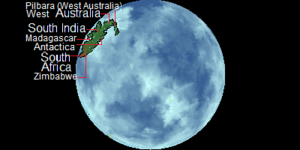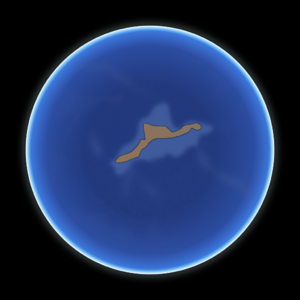Ur (continent) facts for kids

Ur, in the Eoarchean Era
|
|
| Historical continent | |
|---|---|
| Formed | 3.1 Ga |
| Type | Supercontinent |
| Today part of |
|
Ur is a very old, hypothetical (meaning we think it existed, but it's hard to prove) supercontinent. A supercontinent is a huge landmass made of many continents joined together. Scientists believe Ur formed about 3.1 billion years ago during a time called the Archean eon.
When Ur first formed, it might have been the only continent on Earth! Even though it was a supercontinent, it was probably smaller than today's Australia. Some scientists also call Ur and other ancient landmasses "supercratons." A craton is a very old and stable part of the Earth's crust.
Contents
What Was Ur Like?
Scientists believe Ur was a large landmass that existed for a very long time. It was part of bigger supercontinents that formed later. For example, around 1.3 to 1.1 billion years ago, Ur joined with other continents like Nena and Atlantica to create an even bigger supercontinent called Rodinia.
Some ideas suggest that parts of Ur stayed together for a very long time. They might have been a central part of Gondwana, another huge supercontinent that formed much later.
Why Is It Hard to Know About Ur?
It's tricky for scientists to be sure about supercontinents like Ur. This is because the Earth's mantle (the layer beneath the crust) was much hotter billions of years ago. This meant that the way continents moved and changed was different from today. Many things we see in modern plate tectonics, like certain types of rocks, didn't exist or were very rare back then. This makes it hard to reconstruct exactly how these ancient landmasses looked.
How Do Scientists Reconstruct Ur?
Scientists try to figure out how ancient continents were arranged by looking at old rocks and their magnetic properties. They look for similarities in rock layers and how they formed.
For example, some scientists think that two cratons, the Kaapvaal in southern Africa and the Pilbara in western Australia, were once next to each other. They call this idea Vaalbara. However, other ideas about Ur place these two cratons far apart. This shows how different ideas can be when studying such ancient times.
Another idea is for a supercraton called Zimgarn. This name comes from the Zimbabwe and Yilgarn cratons. Zimgarn is thought to be different from both Vaalbara and Ur. Scientists look at things like:
- When the landmasses became stable.
- The types of volcanic rocks found.
- The ancient magnetic directions of the rocks, which tell us where they were on Earth.
These different ideas show how scientists are still working to understand the Earth's very early history!
See also
 In Spanish: Ur (supercontinente) para niños
In Spanish: Ur (supercontinente) para niños


